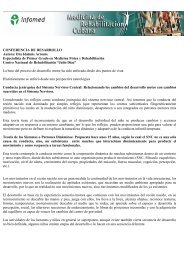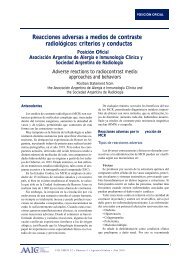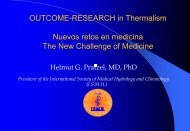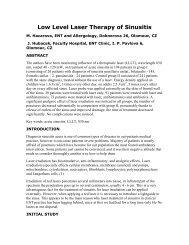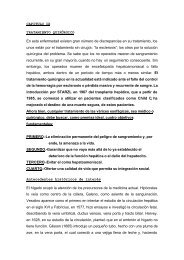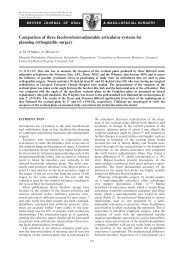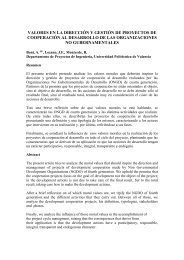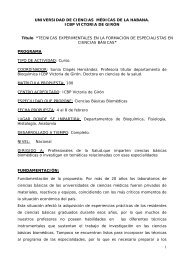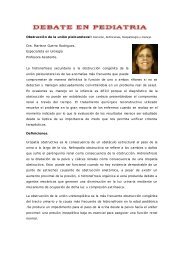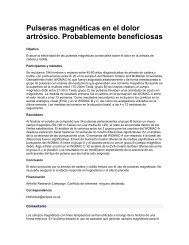Perioperative Anaphylaxis
Perioperative Anaphylaxis
Perioperative Anaphylaxis
You also want an ePaper? Increase the reach of your titles
YUMPU automatically turns print PDFs into web optimized ePapers that Google loves.
<strong>Perioperative</strong> <strong>Anaphylaxis</strong> 443<br />
muscle relaxant responsible for an anaphylactic reaction, but intradermal testing<br />
should be preferred when investigating cross-reaction. 93 Latex sensitization must<br />
be investigated by prick tests using two different commercial extracts. 94 Both prick<br />
and intradermal tests have been proposed in the literature for the diagnosis of sensitization<br />
to blue dyes; however, false-negative prick tests have been occasionally<br />
reported in the literature. These reports strongly suggest favoring intradermal tests<br />
using up to a 1:100 dilution for the diagnosis of sensitization to blue dyes in patients<br />
with a history of a possible immediate hypersensitivity reaction to dyes. 54<br />
MEDIATOR RELEASE TESTS<br />
Basophil Activation Evaluation by Secreted Mediator Assays<br />
Allergen-induced mediator release tests quantify mediators released during effector<br />
cell degranulation, mainly peripheral blood basophils, following stimulation with<br />
specific antigen. There are two categories of mediator release tests: histamine release<br />
tests and sulphidoleukotriene release tests (cellular allergen stimulation test). Mata<br />
and colleagues 95 evaluated in vitro leukocyte histamine release tests for the diagnosis<br />
of allergy to muscle relaxant drugs in 40 patients and a control group of 44 subjects<br />
with negative leukocyte histamine release. The tests were positive in 65% of the<br />
allergic patients, for a threshold corresponding to specificity at 100%. The concordance<br />
between the leukocyte histamine release test and QAS-RIA was 64%. 95,96<br />
Despite good specificity, the diagnostic application of these tests remains limited<br />
because of the heavy experimental conditions and insufficient sensitivity; therefore,<br />
they are not used as routine diagnostic tests. 2 They could be useful when cross-reactivity<br />
among muscle relaxants is investigated with a view to future anesthesia in sensitized<br />
patients. Similarly, reports concerning the monitoring of serotonin, 97 eosinophil<br />
cationic protein, 98 or LTC4 99 release have also been published; however, these assays<br />
cannot be recommended in routine clinical practice at the present time.<br />
Flow Cytometry<br />
The basis of flow-assisted allergy diagnosis relies on quantification of shifts in the<br />
expression of basophilic activation markers after challenge with a specific allergen<br />
using specific antibodies conjugated with a fluorochrome or dye. Activated basophils<br />
not only secrete quantifiable bioactive mediators but also up-regulate the expression<br />
of different markers which can be detected efficiently by flow cytometry using specific<br />
monoclonal antibodies. 69,100–103 Currently, the most commonly used antibody in<br />
allergy diagnosis is anti-CD63 and, to a lesser extent, anti-CD203c. This technique<br />
has been clinically validated for several classical IgE-mediated allergies, including<br />
indoor and outdoor inhalant allergies, primary and secondary food allergies, natural<br />
rubber latex allergy, Hymenoptera venom allergy, and some drug allergies. 69 Although<br />
it does not allow differentiating between IgE-dependent and IgE-independent basophil<br />
activation, it is anticipated that it might constitute a unique tool in the diagnosis<br />
of IgE-independent hypersensitivity reactions as well as the diagnosis of IgE-mediated<br />
anaphylaxis when a specific IgE assay is unavailable. 69,104 Several methodologic<br />
issues remain to be addressed, including realization of the test on whole blood or isolated<br />
basophils, the need for preactivation with IL-3, the choice of appropriate dose for<br />
different allergens, positive and negative controls, characterization and activation<br />
markers, and the appropriate diagnostic threshold for different allergens. 69 Nevertheless,<br />
once fully validated, the basophil activation test using flow cytometry will<br />
probably represent an interesting diagnostic tool for NMBA anaphylaxis and crosssensitization<br />
studies.



